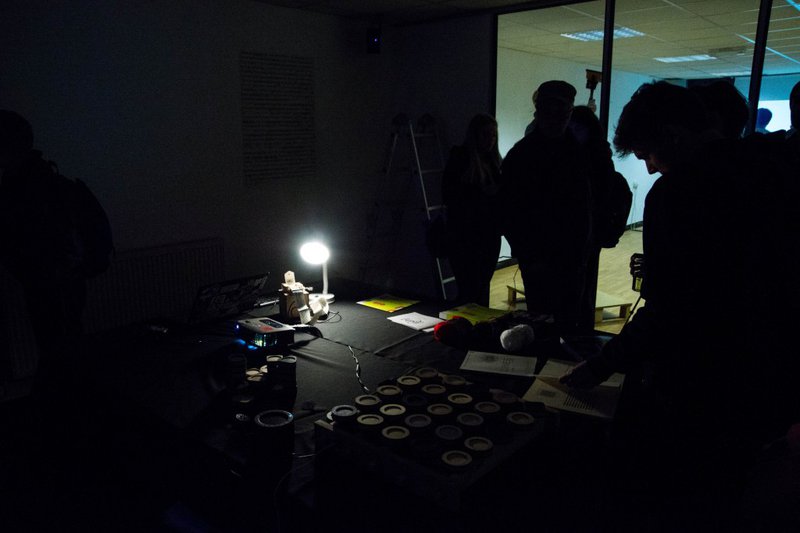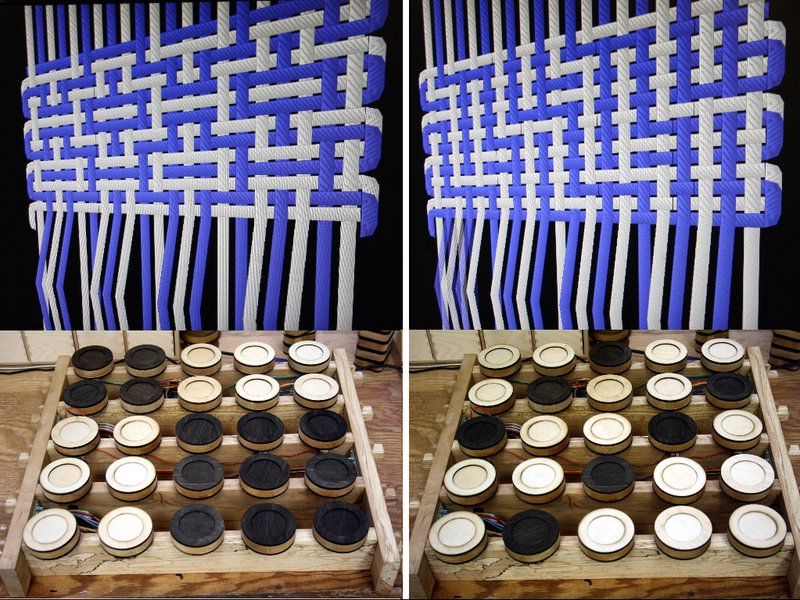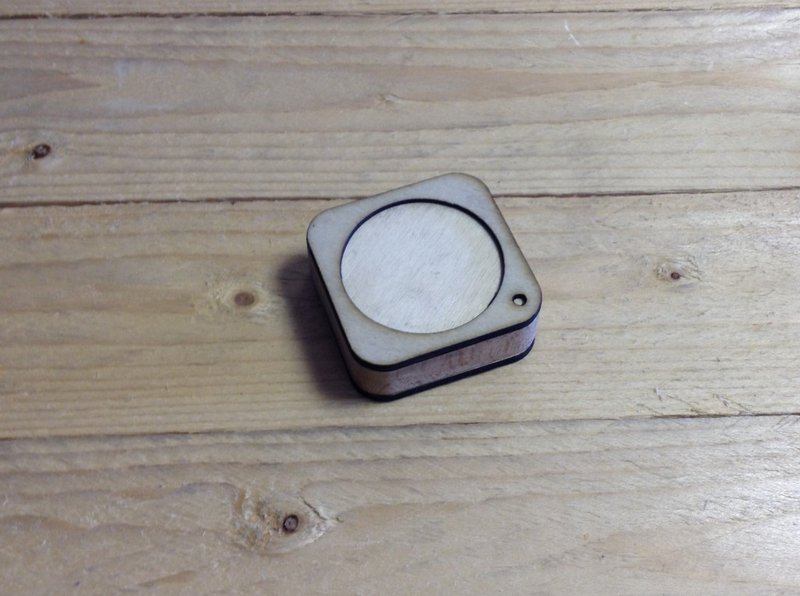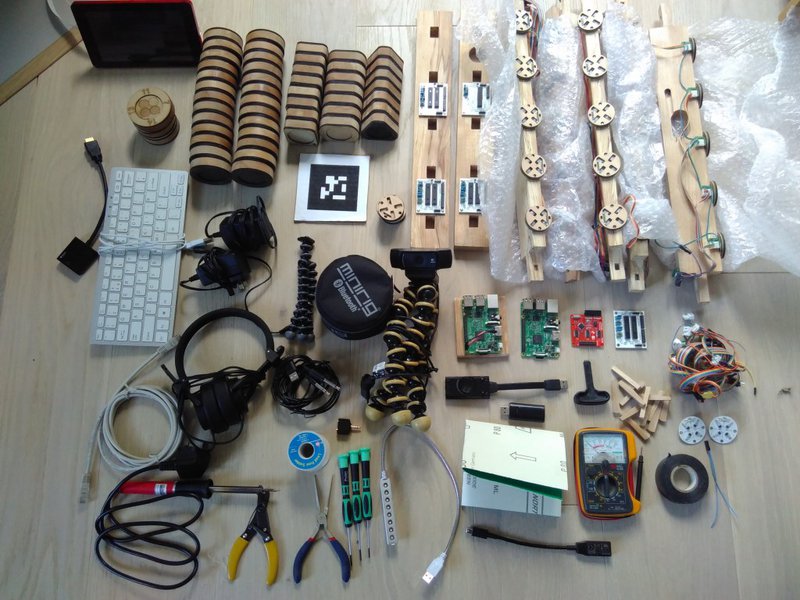Pattern Matrix at Algomech (part 1)
Posted Nov. 23, 2017 by Dave GriffithsI'm writing this on the train with a slightly sleep deprived brain fizzing and popping from thoughts, ideas and conversations from this year's Algomech festival in Sheffield. The Penelope project took a significant role in the festival, with the group's participation in the Unmaking Symposium, the exhibition and also testing our latest weavecoding technology at the Algorave. I'll be writing more on the algorave in a subsequent post.
During the symposium we discussed the critical, liberating and potentially dangerous aspects of Unmaking in a wide variety of contexts - from reverse engineering knitwear and classical Greek dance to discovering the untapped abilities of classical musical instruments when human limitations become a secondary consideration. The symposium also provided us with a good opportunity to take stock of our own group's current directions and thinking in regard to the Penelope project.

Pix thanks to James Vanderhoven

We also had our own corner of the Algomech exhibition, which included Jacquard woven experiments, the Quipu sonification and visualisation and the first public trials of the new pattern matrix V2.

As is our usual practice, we used this exhibition to get essential feedback on our new design for the pattern matrix, as well as the interpretation of what we are doing - being there in person talking to people allows you to very quickly determine what works, and adapt the focus based on the responses you get.
We discussed the long view on digital technology, the role of weavers in foundations of western mathematics and simply the practicalities of the technology we are developing - the constant stream of visitors represented a wide range of different ages and backgrounds. These aspects of the pattern matrix seemed significant (in no particular order):
- The construction technique was immediately interesting to most people, specifically the material, beech wood spalting and open frame construction.
- Related to this, there seems little association with the pattern matrix as a 'device' in the sense of a 'gizmo' - which is interesting as the Raspberry Pi and other PCBs are clearly visible. We've noticed this at some level with the previous version but with the wood construction this effect is much more pronounced.
- It is seen as being game like, e.g. a "70's educational toy". There is an expectation that it is something to be 'played', and similarly its potential as a musical sequencer is a common observation.
- The understandability of the magnet sensing seems a key ingredient. There is no other particularly hidden magic like computer vision or RFID involved, and polarity and digital arrangements of magnets are easily explained and experienced by holding the tokens together.
- Having some extra circuit boards and wood cut parts to hand, originally intended as backups - were great for people who wanted to know more about what was going on. In future we should also have the token block parts to show as well.
- The different shaped blocks were immediately appealing - they seemed to invite experimentation more than alternating the binary tokens by flipping them. To follow this up we need to investigate ways to use different shapes to configure thread colour at the same time as structure in a better way than we are now. The black/white sides could define structure while the shape could correspond to the colour for the specific thread. It also indicates that using shaped tokens as instructions for tablet weaving is worth experimenting with quite soon.
- Younger children focused on the blocks alone (and of course tried all sorts of things no one else did, like stacking them) but slightly older children worked out they were having an effect on the weaving process and generally could patiently work themselves it out without any explanation required.
- Having Anni Albers' 'On Weaving' book next to pattern matrix helped with older visitors, perhaps representing a more conventional and authoritative source of information to introduce the concepts of notation, structure and pattern in weaving.

Pix thanks to James Vanderhoven

An 8-way tangible colour switching instruction
Physical vs digital - a false dichotomy
More general concepts that came up in conversation included a common theme during Algomech, exploring the inescapably fuzzy boundaries of concepts such as digital, physical and analogue. The myth of the "real world" being analogue and the "virtual world" being digital is a troublesome one to a weaver.
The 'anti-device' effect of the pattern matrix has the potential to explore this conundrum, as it represents a seemingly acceptable demonstration of the physical nature of the digital, and that forms of digital technology have inhabited the world of the reassuringly physical for many millennia of human invention.
Check your supply chains
One aspect of the pattern matrix I picked on for the symposium which came up in the exhibition as well was the fact that the beech wood came from a single tree in Cornwall courtesy of Aaron Moore - and used this as an example of our design philosophy of taking on the myth of collapse rather than the myth of infinite abundance.

Feedback from Penelope team members
Having a 5X5 grid initially was thought to be excessive, as most ancient weaves can be expressed with a 4X4 matrix. This larger capability turns out to be more important than we first thought, as it means you can demonstrate the importance of odd and even numbers in the mathematics of weaving.
There is a problem with the single colour change block due to a faulty use of the code from the old version. This has always been a somewhat temporary feature so we should sort this out properly (e.g. using other shapes for colour across the matrix) before we use it next.
We can also try using an augmented reality approach to show the weave structure directly over the grid, so it's easier to see how the token block changes relate to specific crossings. This could be displayed alongside the current warp weighted loom rather than as a replacement for it.
Created: 15 Jul 2021 / Updated: 15 Jul 2021

